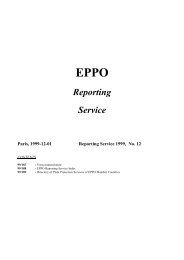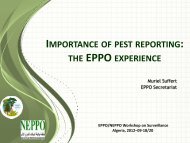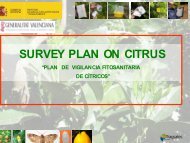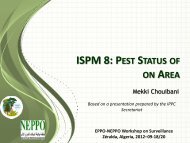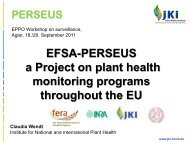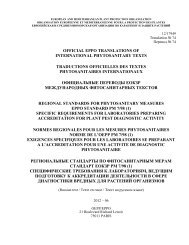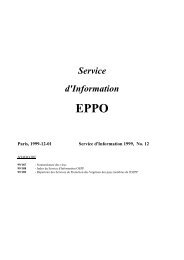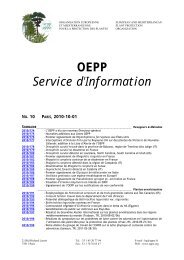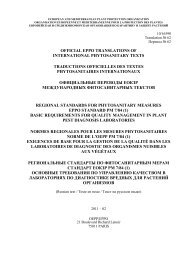Use of phytosanitary certificates - Lists of EPPO Standards ...
Use of phytosanitary certificates - Lists of EPPO Standards ...
Use of phytosanitary certificates - Lists of EPPO Standards ...
Create successful ePaper yourself
Turn your PDF publications into a flip-book with our unique Google optimized e-Paper software.
Blackwell Oxford, EPP Bulletin 0250-8052 OEPP/<strong>EPPO</strong>, 10.1111/j.1362-2338.2004.00710.x<br />
34 Original UK OEPP/<strong>EPPO</strong> Article Publishing, 2004 Bulletin Ltd.<br />
34 Original <strong>EPPO</strong> <strong>Use</strong> <strong>of</strong> <strong>Standards</strong> <strong>phytosanitary</strong> Article <strong>certificates</strong><br />
© 2004 OEPP/<strong>EPPO</strong>, Bulletin OEPP/<strong>EPPO</strong> Bulletin 34,<br />
141–144<br />
Organisation Européenne et Méditerranéenne pour la Protection des Plantes<br />
European and Mediterranean Plant Protection Organization<br />
Normes OEPP<br />
<strong>EPPO</strong> <strong>Standards</strong><br />
<strong>Use</strong> <strong>of</strong> <strong>phytosanitary</strong> <strong>certificates</strong><br />
Utilisation des certificats phytosanitaires<br />
PM 1/1 (revised/révisée)<br />
Organisation Européenne et Méditerranéenne pour la Protection des Plantes<br />
1, rue Le Nôtre, 75016 Paris, France<br />
141
142 <strong>Use</strong> <strong>of</strong> <strong>phytosanitary</strong> <strong>certificates</strong><br />
Approval<br />
<strong>EPPO</strong> Standard PM 1/1 was first approved by <strong>EPPO</strong> Council in<br />
1991-09. A revision was approved in 2003-09. In the terms <strong>of</strong><br />
Article II <strong>of</strong> the IPPC, it is a Regional Standard for the members<br />
<strong>of</strong> <strong>EPPO</strong>.<br />
Review<br />
<strong>EPPO</strong> <strong>Standards</strong> are subject to periodic review and amendment.<br />
The next review date for this <strong>EPPO</strong> Standard is decided by the<br />
<strong>EPPO</strong> Working Party on Phytosanitary Regulations.<br />
Amendment record<br />
Amendments will be issued as necessary, numbered and dated.<br />
Distribution<br />
<strong>EPPO</strong> <strong>Standards</strong> are distributed by the <strong>EPPO</strong> Secretariat to all<br />
<strong>EPPO</strong> Member Governments. Copies are available to any<br />
interested person under particular conditions upon request to<br />
the <strong>EPPO</strong> Secretariat.<br />
Scope<br />
This standard gives guidance to <strong>EPPO</strong> Member Governments<br />
on the definition in their <strong>phytosanitary</strong> regulation <strong>of</strong><br />
requirements for <strong>phytosanitary</strong> <strong>certificates</strong> to accompany<br />
imported consignments <strong>of</strong> plants, plant products and other<br />
commodities.<br />
References<br />
IPPC (1997a) New revised text <strong>of</strong> the International Plant Protection Convention.<br />
IPPC Secretariat, FAO, Rome (IT).<br />
IPPC (1997b) Export certification system. International <strong>Standards</strong> for Phytosanitary<br />
Measures No. 7.<br />
IPPC Secretariat, FAO, Rome (IT) .<br />
IPPC (2001) Guidelines for <strong>phytosanitary</strong> <strong>certificates</strong>. International <strong>Standards</strong><br />
for Phytosanitary Measures No. 12.<br />
IPPC Secretariat, FAO, Rome<br />
(IT) .<br />
IPPC (2003) Glossary <strong>of</strong> <strong>phytosanitary</strong> terms. International <strong>Standards</strong> for<br />
Phytosanitary Measures No. 5 (revised). IPPC Secretariat, FAO, Rome (IT) .<br />
34 Original <strong>EPPO</strong> <strong>Use</strong> <strong>of</strong> <strong>Standards</strong> <strong>phytosanitary</strong> Article <strong>certificates</strong><br />
© 2004 OEPP/<strong>EPPO</strong>, Bulletin OEPP/<strong>EPPO</strong> Bulletin 34,<br />
141–144
© 2004 OEPP/<strong>EPPO</strong>, Bulletin OEPP/<strong>EPPO</strong> Bulletin 34,<br />
141–144<br />
<strong>EPPO</strong> <strong>Standards</strong> 143<br />
European and Mediterranean Plant Protection Organization PM 1/1(2)<br />
Organisation Européenne et Méditerranéenne pour la Protection des Plantes<br />
<strong>Use</strong> <strong>of</strong> <strong>phytosanitary</strong> <strong>certificates</strong><br />
Utilisation des certificats phytosanitaires<br />
Member Governments are recommended:<br />
1 to adopt the use <strong>of</strong> <strong>phytosanitary</strong> <strong>certificates</strong> (PC) and <strong>of</strong><br />
<strong>phytosanitary</strong> <strong>certificates</strong> for re-export (RC) as specified in<br />
the New Revised Text <strong>of</strong> the International Plant Protection<br />
Convention1.<br />
2 to include on all PCs the optional clause ‘They are deemed<br />
to be practically free from other pests.’<br />
3 to respect ISPMs N°<br />
7 ‘Export certification system’ and N°<br />
12<br />
‘Guidelines for <strong>phytosanitary</strong> <strong>certificates</strong>’ and, in particular:<br />
• to avoid filling into the PC (or RC) any information <strong>of</strong> a<br />
non-<strong>phytosanitary</strong> nature. Only appropriate disclaimers<br />
related to legal liability may be included. When necessary,<br />
a note may be attached associating the PC (or RC)<br />
with the identification code, symbol or number(s) <strong>of</strong><br />
other relevant consignment documents requiring crossreferencing<br />
(the note is not considered an <strong>of</strong>ficial part <strong>of</strong><br />
the PC or RC);<br />
• to fill in the PC (or RC) heading ‘place <strong>of</strong> origin’ with at<br />
least the name <strong>of</strong> the country where the consignment<br />
gained its <strong>phytosanitary</strong> status, i.e. where it was exposed<br />
to possible infestation or contamination by pests. Countries<br />
may require that ‘pest-free areas’, ‘pest-free places<br />
<strong>of</strong> production’ or ‘pest-free production sites’ are identified<br />
in sufficient detail in this section;<br />
• to use scientific names without uncertified alterations or<br />
erasure.<br />
4 to require that the PC (or RC) should be filled in typescript<br />
(or capital letters) in Latin script.<br />
5 to require that the PC (or RC) should be made out not more<br />
than 14 days before export <strong>of</strong> the consignment.<br />
6 to require imported plants to be accompanied by the PC (or<br />
RC) but with the following general exceptions: plants not<br />
for planting, i.e. cut flowers and branches, fruits and vegetables.<br />
Nevertheless, in specific cases arising from <strong>EPPO</strong><br />
<strong>Standards</strong> PM 2 Pest-Specific Phytosanitary Requirements,<br />
<strong>EPPO</strong> may recommend that a PC (or RC) should accompany<br />
such commodities (e.g. potatoes other than seed potatoes,<br />
certain cut flowers, certain fruits).<br />
1This<br />
is implicit in Council’s recommendation <strong>of</strong> 1998 that Member<br />
Governments should adhere to the IPPC, and accept the amendments agreed<br />
by FAO Conference in 1997-11.<br />
7<br />
8<br />
9<br />
10<br />
11<br />
to require seeds to be accompanied by the PC (or RC) only<br />
in specific cases arising from <strong>EPPO</strong> <strong>Standards</strong> PM 2 Pest-<br />
Specific Phytosanitary Requirements.<br />
without prejudice to (6) and (7), not in general to require<br />
plant products or other commodities to be accompanied by<br />
a PC (or RC). Nevertheless, in certain cases arising from the<br />
<strong>EPPO</strong> Pest-Specific Phytosanitary Requirements, <strong>EPPO</strong><br />
may recommend that a PC (or RC) should accompany<br />
certain plant products (wood <strong>of</strong> certain species) or other<br />
commodities (growing media) .<br />
to require any imported plants or plant products accompanied<br />
by a PC (or RC) to be free from all the quarantine pests<br />
in the list <strong>of</strong> regulated pests <strong>of</strong> that Member Government2.<br />
to require all plants and plant products and other articles<br />
subject to <strong>phytosanitary</strong> measures for quarantine or regulated<br />
non-quarantine pests to be accompanied by a PC (or<br />
RC), whose statement that the consignment is ‘considered<br />
to conform with the current <strong>phytosanitary</strong> regulations <strong>of</strong> the<br />
importing country’ certifies that those <strong>phytosanitary</strong> measures<br />
are respected3.<br />
not in general to require that conformity with <strong>phytosanitary</strong><br />
requirements should be attested by an additional declaration<br />
even though the PC and RC allow for such declarations,<br />
but rather to require such declarations only when necessary.<br />
As an example <strong>of</strong> a necessary additional declaration, the<br />
exporting country’s choice <strong>of</strong> option should be indicated<br />
when the import regulation allows for more than one option<br />
for <strong>phytosanitary</strong> certification <strong>of</strong> a particular plant or plant<br />
product.<br />
2Nevertheless,<br />
it is recognized that certain plants and plant products are<br />
much more likely to be infested by specific quarantine pests than others.<br />
Accordingly, for each quarantine pest, <strong>EPPO</strong> specifies in the PSPR the<br />
main plants and plant products which should be inspected. If a visual<br />
inspection <strong>of</strong> the consignment is not considered sufficient, other<br />
requirements may alternatively or additionally be made. This includes<br />
inspections done by ‘appropriate procedures’ other than simple visual<br />
examination. These procedures will then be described and recommended<br />
(<strong>EPPO</strong> <strong>Standards</strong> PM 3 Phytosanitary procedures).<br />
3In<br />
certain special cases, however, it may be accepted that another certificate<br />
could replace the PC to certify conformity with certain Pest-Specific<br />
Phytosanitary Requirements (e.g. debarking certificate).<br />
143
144 <strong>Use</strong> <strong>of</strong> <strong>phytosanitary</strong> <strong>certificates</strong><br />
12<br />
to envisage, where practicable, exempting plants from the<br />
<strong>EPPO</strong> region from the PC (or RC) requirements in the following<br />
cases: 1) small quantities carried by travellers for<br />
their personal use (which nevertheless remain subject to<br />
any prohibitions and may be subject to random import<br />
inspection), 2) plants subject to special bilateral <strong>phytosanitary</strong><br />
arrangements for places <strong>of</strong> production situated at<br />
frontiers.<br />
13<br />
not to require from the country <strong>of</strong> transit4<br />
<strong>of</strong> a consignment<br />
<strong>of</strong> plants or plant products further inspection or issue <strong>of</strong> a<br />
PC (whether original or re-export).<br />
4<br />
According to ISPM No. 5, a consignment is in transit if it passes through a<br />
country without being imported. The consignment may not be split up,<br />
combined with other consignments or have its packaging changed.<br />
© 2004 OEPP/<strong>EPPO</strong>, Bulletin OEPP/<strong>EPPO</strong> Bulletin 34,<br />
141–144




